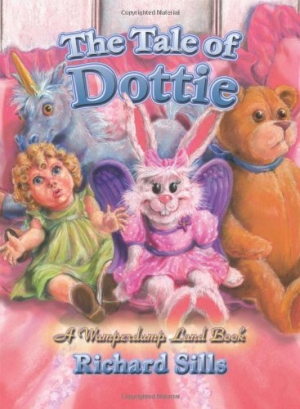The Tale of Dottie
A Wumperdump Land Book
Vibrant illustrations grace this optimistic tale of a doll who longs to be human.
In the vein of Pinocchio and The Velveteen Rabbit, Richard Sills’s new work features a “bunny doll with angel wings” whose desire to spring to life results in adventure. The Tale of Dottie: A Wumperdump Land Book mixes fairy tale elements; characters from Mother Goose, The Wizard of Oz, and Star Wars; and aspects of modern technology to reveal a dream-like journey.
The story casts Dottie’s future in a traditional light, as her godmother predicts, “You will be the little girl of your dreams—and I see a little boy whom you will meet and marry if you are good and do the things that you should do.” Armed with this blessing, Dottie sets out in search of answers. Through a series of encounters with other characters who guide and lead her back to her godmother, she gradually experiences rebirth.
Parents who seek resourceful, independent role models in contemporary children’s fiction may hesitate at Dottie’s passivity, and at the idea of a relationship as her reward for obedience. That Dottie is aided primarily because she is “sweet and beautiful” and has the “wings of an angel” could also seem limiting. Still, the plot offers some variation to a common fairy tale pattern—in which girls in need are rescued by love—through its eclectic medley of borrowed sources.
Some choices are puzzling, including the use of the droid R2-D2, and an object named The Gold Cross of Richie Rich; both R2-D2 and Richie Rich are popular, iconic characters with their own associations that distract from the work. Other uses of familiar characters, such as those from The Wizard of Oz, are more in keeping with the woodland ambiance portrayed in the vibrant illustrations. These secondary characters serve as kind participants in Dottie’s quest, which remains free of major obstacles. Dottie herself remarks, “That was easy enough. It looks like this is a puzzle with all the answers following the questions. Everything seems to open up for me just like a lock and a key.”
The benign climate of the book should appeal to the youngest readers. For older children, Dottie’s effortless transformation is a missed opportunity for character growth.
Stronger moments in the writing include a rhyming sequence in the opening chapter, which encourages a whimsical, read-aloud practice: “And now, tapping my heels three times, / Upon my journey towards life I go, / Merrily, as in the sun, as in the snow.” Repetitions, including numerous sentences that begin with “So” and lines that repeat actions, such as “Dottie fell asleep as dolls often do when they are alone” followed by “So, little Dottie fell asleep” could be trimmed.
As a straightforward account of a character following a set path, this is a pleasant, breezy read that encourages optimism.
Reviewed by
Karen Rigby
Disclosure: This article is not an endorsement, but a review. The publisher of this book provided free copies of the book and paid a small fee to have their book reviewed by a professional reviewer. Foreword Reviews and Clarion Reviews make no guarantee that the publisher will receive a positive review. Foreword Magazine, Inc. is disclosing this in accordance with the Federal Trade Commission’s 16 CFR, Part 255.

